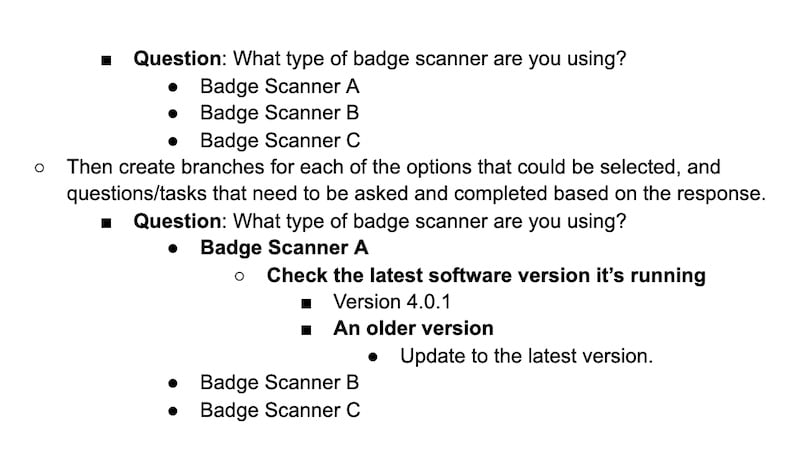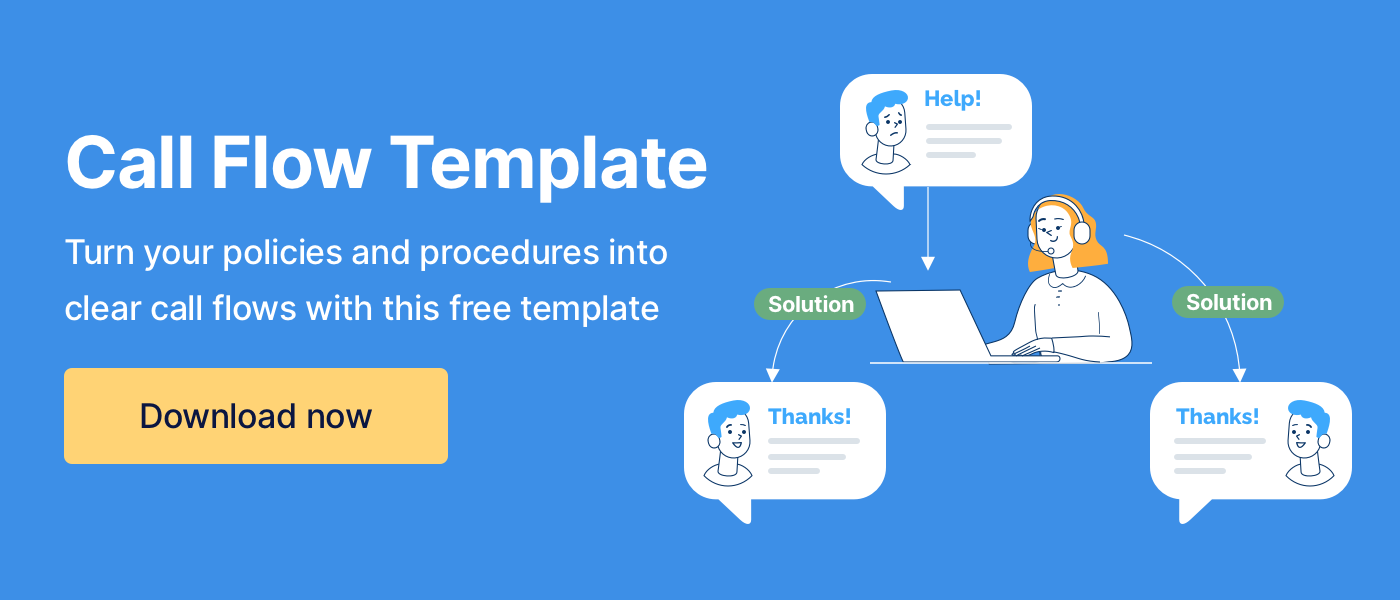How to Reduce Escalation in a Call Center With Procedures (6 Steps)
When we talk with call centers that handle a lot of troubleshooting calls, they often have a common goal — to reduce call escalations.
Different call centers have different consequences for when reps can’t successfully troubleshoot.
Sometimes it means they need to bring in a more technical person. Other times it means that the company needs to unnecessarily swap out a device that’s actually okay. Or maybe they unnecessarily send somebody to pay a personal visit when it could have been resolved over the phone.
When reps don’t troubleshoot calls correctly, it’s costing you money. Call escalations take additional time as they require multiple employees to talk to a caller. Plus, they frustrate the caller since they have to repeat themselves over and over again.
At ScreenSteps — a knowledge base software company that supports call centers — I’ve coached call center trainers and managers on ways to write procedures so they can help their reps avoid escalating calls.
In this article, I’ll first go over how having well-documented procedures for your troubleshooting calls is one of the best solutions for reducing escalation calls. Then I’ll share six steps for writing those troubleshooting procedures so you can hopefully reduce escalations in your call center.
What causes call escalations in a call center?
To reduce the number of escalated calls in your call center, you need to understand why your escalations are happening. There are many reasons an agent could escalate a call:
- The caller is angry and they don’t know how to de-escalate the caller
- The caller doesn’t believe the agent has the skills to help them
- The agent doesn’t have the skills to handle the situation
Sometimes all it takes to reduce escalations in your call center is further training. For example, you can teach your agents how to show more empathy to help an angry caller settle down.
You can train agents on new procedures and skills. However, it is nearly impossible to teach agents and have them memorize every possible scenario they will encounter on the job.
Calls are often escalated because an agent is troubleshooting something that they don’t know how to handle or the caller perceives an agent can’t handle it.
In those instances, the solution is providing help guides that support agents while they are on a call.
Solution: Having well-written troubleshooting procedures
When you clearly document your troubleshooting procedures, it helps prevent call escalations. Well-written guides make it so your agents don’t have to be an expert in every area, situation, etc. in order to help customers.
They can pull up a step-by-step guide while they are on a call, follow the decision tree instructions, and resolve the issue.
If your agents know all the steps to troubleshooting and resolving, then they won’t need to escalate as many calls. This means they know what to do in a variety of scenarios, like all the possibilities for determining why your router isn’t giving the caller an internet signal.
They have to be able to resolve a variety of issues on their own. Even if they’ve never dealt with this specific issue before, it helps if they have reference materials to help callers solve the problem.
So, how do you write helpful roubleshooting procedures?
6 steps to reduce escalation with troubleshooting procedures
Not all troubleshooting procedures are created equal. In these six steps, I provide best practices so that you can fulfill the purpose of helping agents resolve issues on their own. Then they won’t need to escalate calls.
1. Identify the types of calls your company receives
To know what specific procedures you need to write, you first need to brainstorm what type of calls your company receives. What situations cause people to call into your company?
These are troubleshooting scenarios that require you to uncover a problem and resolve it. Some example situations are:
- Badge reader isn’t scanning
- Error code 204583
- Can’t log in
- Internet isn’t working
Write a list of these types of calls in a chart or Google sheet.
2. Identify the common reasons for problems
Once you identify the types of calls that can be troubleshot, the next step is to identify the common reasons for problems.
Why could this problem happen? What issues cause these problems? If it’s the possible cause of a problem, then it needs to be included in your list.
For example, some of the reasons why a badge reader might not work include:
- Badge has a scratch on it
- Badge has gunk on it
- Badge is the wrong kind
- Badge expired
- Machine is unplugged
- Software is outdated
Caveat: If you are getting a lot of calls where experts truly are needed on every troubleshooting call because there’s no repeatable process for troubleshooting, then you may not be able to reduce escalation. Since each situation is different and there’s no formula for consistently fixing what’s going on, you need experts on every call.
3. Identify the actionable steps for each reason
Now that you have a list of calls along with possible reasons, the next step is to identify steps that should be taken for each reason. For each of the reasons (or possible problem causes), you need a procedure to explain what agents need to do.
Continuing the badge reader example, here are the steps that an agent would need to take if a badge has a scratch on it. The steps include:
- If badge has scratch on it, the badge must be replaced.
- To get past the badge scanner in the short-term, person can manually type in employee code on badge and confirm the employee should have access.
You are listing out the steps in consecutive order of how an agent would need to complete the task or the order in which they would need to guide the caller.
4. Optimize the troubleshooting process
Next, you must determine the best order for discovering the root cause of the problem. When someone calls into a call center, they are hoping to resolve the issue as quickly as possible. That’s why you have call center metrics to measure how fast and well your agents serve your callers.
For example, if the internet isn’t working, the first place you should begin is making sure the router is plugged into an outlet. Otherwise, you could waste a lot of time looking at passcodes and IP addresses.
The order of questions should rule things out in the least amount of questions possible. It’s kind of like playing Guess Who. You want to discover who your opponent has in as few questions as possible.
5. Write troubleshooting flows that are conversational
Now that you’ve gathered your information and decided on your priorities, you need to write troubleshooting call flows that are conversational.
Call flows are procedural help guides that prompt your agents on what to do while they are on a call. The step-by-step instructions help them avoid missing steps and get things done in an optimal order.
Record your subject matter experts handling a real troubleshooting call. Choose someone who you consider your ideal worker at handling specific calls. Then write a troubleshooting flow that follows their questions.
Here’s an outline of how a call flow would look for troubleshooting a malfunctioning badge.

🔍 Related: How to write your first call flow if your call center doesn't have documented procedures
6. Use a tool with interactive decision trees
Consider using a tool that allows you to create interactive decision trees. This will make it easier for reps to follow what is going on. An interactive decision tree walks an agent through a call exactly in the order you outline for them.
With interactive decision trees, you reduce mistakes and provide solutions with easy-to-follow call flows. Since it is a simple process for your agents to follow your call flows, they can complete calls — meaning they don’t need to escalate as many calls.
Tools — such as a knowledge base or employee enablement software — can have interactive decisions trees. But, not all brands have this feature.
Depending on the tool you use, you may even be able to track your employees’ performance. This will help you discover missing solutions in your call flow and procedures as well as know whether the agent needs more training.
Need a tool to help your agents with troubleshooting calls?
Call center agents need to know a lot of information. When you provide them with carefully curated call flows in an accessible tool, it takes the pressure off of your agents and, ultimately, your managers. That’s because agents can handle the calls and don’t need to escalate calls so frequently.
The ScreenSteps knowledge base software includes interactive decision trees in the form of workflow articles. These articles are fast and easy to create with our simple yet powerful content creation tools.
Then your agents can access those articles in as few as two clicks. That means not putting callers on hold while an agent looks for the correct troubleshooting procedure.
Think a knowledge base could help your call center agents? Learn more about knowledge base software — what it is, what features it has, and more — with this basic introduction to knowledge base software.


.png)

